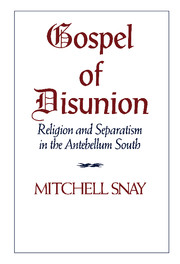Book contents
- Frontmatter
- Contents
- Acknowledgments
- Introduction: Religion and the search for Southern distinctivenes
- PART ONE RELIGION AND SECTIONAL POLITICS
- PART TWO RELIGION AND SLAVERY
- PART THREE RELIGION AND SEPARATISM
- 4 Harbingers of disunion: The denominational schisms
- 5 The religious logic of secession
- 6 Religion and the formation of a Southern national ideology
- Conclusion: Religion, the origins of Southern nationalism, and the coming of the Civil War
- Bibliography
- Index
4 - Harbingers of disunion: The denominational schisms
from PART THREE - RELIGION AND SEPARATISM
Published online by Cambridge University Press: 07 September 2010
- Frontmatter
- Contents
- Acknowledgments
- Introduction: Religion and the search for Southern distinctivenes
- PART ONE RELIGION AND SECTIONAL POLITICS
- PART TWO RELIGION AND SLAVERY
- PART THREE RELIGION AND SEPARATISM
- 4 Harbingers of disunion: The denominational schisms
- 5 The religious logic of secession
- 6 Religion and the formation of a Southern national ideology
- Conclusion: Religion, the origins of Southern nationalism, and the coming of the Civil War
- Bibliography
- Index
Summary
The moral debate over slavery eventually seeped into the institutional foundations of American Protestantism, fracturing the major national denominations into separate sectional churches. Slavery played a crucial if indirect role in the division of the Presbyterian church into Old and New School factions in 1837–8. In 1844, a conflict over slavery prompted Southern Methodists to sever their ties with their Northern brethren and form the Methodist Episcopal Church, South. Baptists in the slave states withdrew from their national denominational organizations a year later. Like the Methodists, they too established a separate sectional church. Southern Protestants realized that these disruptions of ecclesiastical harmony posed a clear threat to political unity. “Let the three great religious denominations,” warned an Alabama Baptist in 1845, “the Presbyterian, the Methodist and the Baptist, declare off from union of effort to do good, North and South, and our glorious union of States will be greatly weakened, if not sundered entirely.” Apprehension was also evident among politicians. “If our religious men cannot live together in peace,” noted the Great Compromiser Henry Clay, “what can be expected of us politicians, very few of whom profess to be governed by the great principles of love?” These fears were realized a little more than a decade later as the secession crisis reenacted the scenario of religious schism on the political stage. The denominational splits of the 1830s and 1840s had truly been, in the words of Tennessee Methodist William A. Booth, a “harbinger of disunion.”
- Type
- Chapter
- Information
- Gospel of DisunionReligion and Separatism in the Antebellum South, pp. 113 - 150Publisher: Cambridge University PressPrint publication year: 1993



